
by Sheila Dunning | Sep 30, 2024
Looking to add something to brighten your landscape this autumn? Firespike (Odontonema strictum) is a prolific fall bloomer with red tubular flowers that are very popular with hummingbirds and butterflies. It’s glossy dark green leaves make an attractive large plant that will grow quite well in dense shade to partial sunlight. In frost-free areas, firespike grows as an evergreen semi-woody shrub, spreads by underground sprouts and enlarges to form a thicket.

Bright red blooms of Firespike
In zones 8 and 9 it usually dies back to the ground in winter and resprouts in spring, producing strikingly beautiful 9-12 inch panicles of crimson flowers beginning at the end of summer and lasting into the winter each year. Firespike is native to open, semi-forested areas of Central America. It has escaped cultivation and become established in disturbed hammocks throughout peninsular Florida, but hasn’t presented an invasive problem. Here in the panhandle, firespike will remain a tender perennial for most locations. It can be grown on a wide range of moderately fertile, sandy soils and is quite drought tolerant. Firespike may be best utilized in the landscape in a mass planting. Plants can be spaced about 2 feet apart to fill in the area quickly. It is one of only a few flowering plants that give good, red color in a partially shaded site. The lovely flowers make firespike an excellent candidate for the cutting garden and is a “must-have” for southern butterfly and hummingbird gardens. Additional plants can be propagated from firespike by division or cuttings. However, white-tailed deer love firespike too, and will eat the leaves, so be prepared to fence it off from “Bambi”.
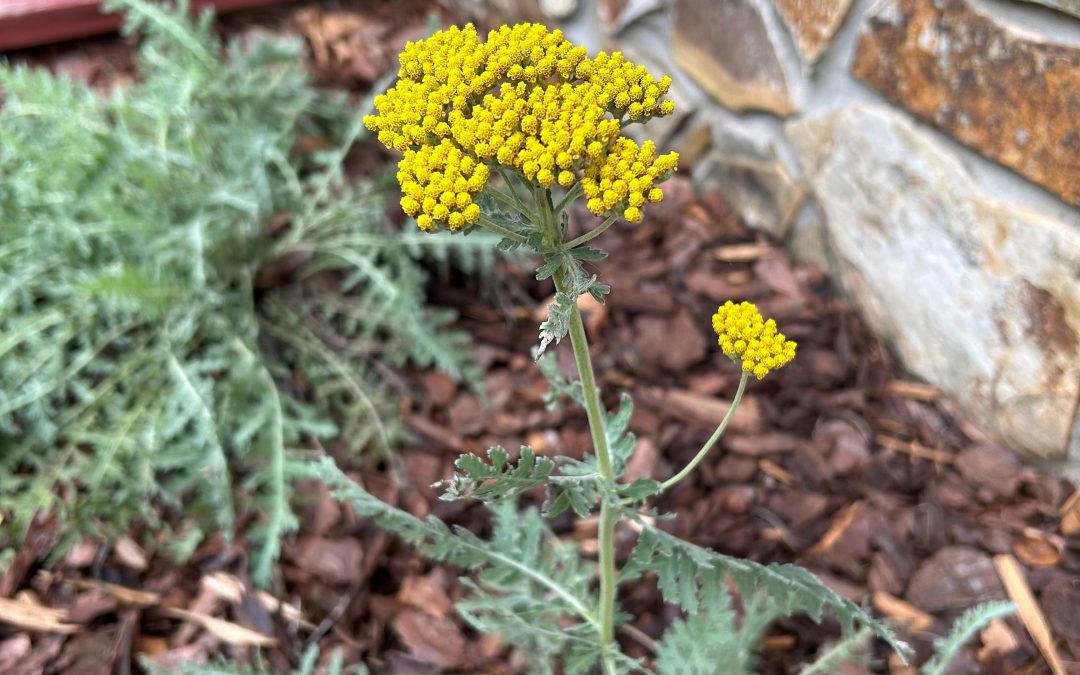
by Daniel J. Leonard | Sep 19, 2024
Problem areas in the landscape – everyone has them. Whether it’s the spot near a drain that stays wet or the back corner of a bed that sunshine never touches, these areas require specialized plants to avoid the constant frustration of installing unhealthy plants that slowly succumb and must be replaced. The problem area in my landscape was a long narrow bed, sited entirely under an eave with full sun exposure and framed by a concrete sidewalk and a south-facing wall. This bed stays hot, it stays dry, and is nigh as inhospitable to most plants as a desert. Enter a plant specialized to handle situations just like this – Yarrow ‘Moonshine’.
Yarrow (Achillea spp.) is a large genus of plants, occurring all over the globe. To illustrate, Common Yarrow (Achillea millefolium) is native to three different continents (North America, Europe, and Asia), making it one of the most widely distributed plants in the world. And though it was commonly grown and used in antiquity for medical purposes (the genus name Achillea is a reference to Achilles, who supposedly used the plant as a wound treatment for himself and his fellow Greek soldiers), I and most of you are probably more interested in how it looks and performs in the landscape.
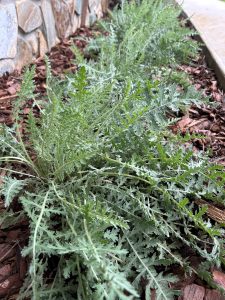
‘Moonshine’ Yarrow foliage.
All species of Yarrow share several ornamental traits. The most obvious are their showy flowers, which occur as large, flattened “corymbs” and come in shades of white, pink, red, and yellow. I selected the cultivar ‘Moonshine’ for my landscape as it has brilliant yellow flowers that popped against the brown wall of the house. Equally as pretty and unique is the foliage of Yarrow. Yarrow leaves are finely dissected, appearing fernlike, are strongly scented, and range in color from deep green to silver. Again, I chose ‘Moonshine’ for its silvery foliage, a trait that makes it even more drought resistant than green leaved varieties.

‘Moonshine’ Yarrow inflorescence.
If sited in the right place, most Yarrow species are easy to grow; simply site them in full sun (6+ hours a day) and very well drained soil. While all plants, Yarrow included, need regular water during the establishment phase, supplemental irrigation is not necessary and often leads to the decline and rot of Yarrow clumps, particularly the silver foliaged varieties like ‘Moonrise’ (these should be treated more like succulents and watered only sparingly). Once established, Yarrow plants will eventually grow to 2-3’ in height but can spread underground via rhizomes to form clumps. This spreading trait enables Yarrow to perform admirably as a groundcover in confined spaces like my sidewalk-bound bed.
If you have a dry, sunny problem spot in your landscape and don’t know what to do, installing a cultivar of Yarrow, like ‘Moonshine’, might be just the solution to turn a problem into a garden solution. This drought tolerant, deer tolerant, pollinator friendly species couldn’t be easier to grow and will reward you with summer color for years to come. Plant one today. For more information on Yarrow or any other horticultural question, contact your local UF/IFAS County Extension Office.

by Beth Bolles | Sep 4, 2024
Two years ago, the Escambia Master Gardener Volunteers were gifted with the flowering perennial Sweet Almond bush (Aloysia virgata). It has quickly become a favorite plant of volunteers and garden visitors due to its many attractive features.
Although, Sweet almond bush is not a Florida native, it is Florida-friendly plant for zones 8b -10b. Plants grow very large, from 6-10 feet with branching that can spread out in all directions. In North Florida, plants can be damaged by a freeze but either return from the base or from growing points higher on branches.
One of the best features are the fragrant white flowers spikes that will be present late spring through fall. Many types of pollinating insects will be attracted to the flowers, although sometimes flowers are too high on the plant for many of us to get a good look at pollinator details.
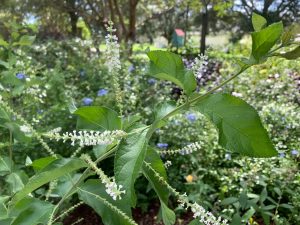
Sweet almond bush blooms. Photo by Beth Bolles, UF IFAS Extension Escambia County
We have plants both in full sun and partial shade that are performing well in the Escambia Demonstration Gardens. Plants do receive water when rainfall is lacking for about 5-7 days (or all of August this year in the Northwest Panhandle). You can shape your plant with a little light pruning during the growing season to keep branches a little more in bounds. Don’t forget to start a few new plants from these cuttings and then share a low maintenance plant with your neighbors.
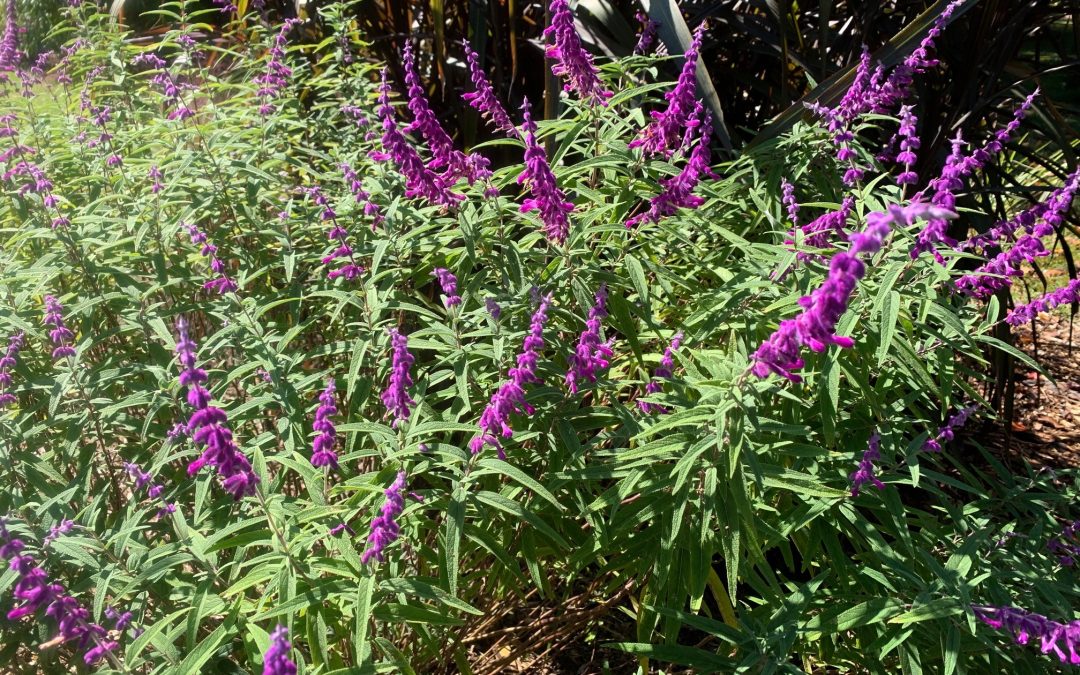
by Beth Bolles | Aug 20, 2024
Salvias are a popular group of plants for attracting pollinators and adding lots of color to the landscape. A unique salvia that offers velvety flowers is the Mexican bush sage, Salvia leucantha.
In our heat, Mexican bush sage can tolerate partial shade and likes average water with well drained soils. Plants will not overtake a spot only growing 2-4 feet. The velvety portion of the flower is a purple calyx with the flower petals emerging white or purple. Flower stalks will extend above the foliage to be available to many bees, butterflies, and hummingbirds.
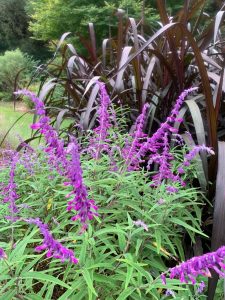
Mexican bush sage planted with ‘First Knight’ pennisetum. Photo by Bolles, UF IFAS Extension Escambia County.
During cold winters, plants can die back to the ground but often return each spring. It is always good to take a few cuttings for new plant starts just in case your plant dies back from heavy rains or drought conditions.
Mexican bush sage can be an accent plant in your garden or used in a small mass of 2-3 plants. Consider adding it with contrasting textures and colors so later summer flowers are easily visible.
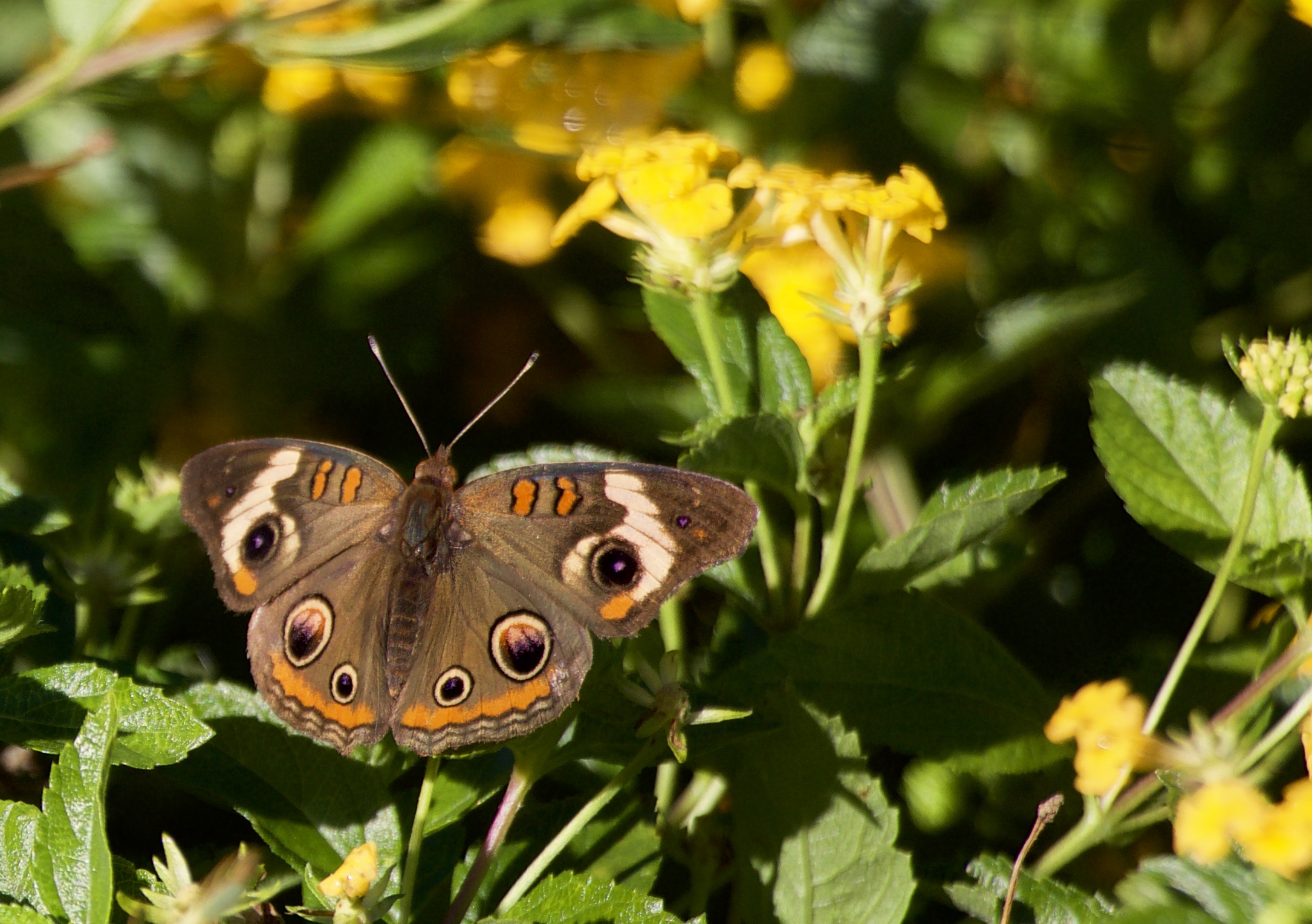
by Sheila Dunning | Aug 7, 2024
The “Dog Days” are the hottest, muggiest days of summer. In the northern hemisphere, they usually fall between early July and early September. The actual dates vary greatly from region to region, depending on latitude and climate. It is miserable right now, but fall is coming.
In ancient times, when the night sky was not obscured by artificial lights, the Romans used the stars to keep track of the seasons. The brightest constellation, Canis Major (Large Dog), includes the “dog star”, Sirius. In the summer, Sirius used to rise and set with the sun, leading the ancient Romans to believe that it added heat to the sun. Although the period between July 3 and August 11 is typically the warmest period of the summer, the heat is not due to the added radiation from a far-away star, regardless of its brightness. The heat of summer is a direct result of the earth’s tilt.
Spending time outdoors this time of year is uncomfortable, potentially dangerous, due to the intense heat. However, the chinch bugs are very active in St. Augustine grass (for more information: http://edis.ifas.ufl.edu/lh036), and the summer flowers need water. So, take care of those tasks early in the day and then retreat to the air conditioning to plan your fall planting.
Plant tomato plants in August for fruit in October. Varieties such as Phoenix, Florida 91, Solar Set and Heat Wave II are good selections for setting fruit in high temperatures, should summer temperatures continue. Otherwise, try some of the newer UF/IFAS recommended varieties for fall planting in North Florida such as Bella Rosa, Tribute or Finishline. For more information on tomato selection refer to: http://edis.ifas.ufl.edu/in756. For information on other vegetables for fall gardening refer to the Florida Vegetable Gardening Guide: http://edis.ifas.ufl.edu/vh021.
Many bedding plants flower quickly and can add color to the fall landscape. These include pentas, African marigolds, torenia, zinnias, melampodium and scaevola. Other can be planted in October for blooms all winter-long. Plan spaces and color themes for calendulas, pansies, snapdragons and violas. Add in ornamental cabbage or kale and some dusty miller to accent the garden. They too will perform through the cold. For more information on Annuals for the Florida Garden refer to: http://edis.ifas.ufl.edu/mg319.
Dependable fall blooming perennials include lion’s ear (Leonotis leonurus), pineapple sage (Salvia elegans), firebush (Hamelia patens), cigar plant (Cuphea micropetala), yellowbells (Tecoma stans) and firespike (Odontonema strictum). Also, garden mums (Chrysanthemum sp.) and many different Irises will add color again in the spring. To gain information on perennials for Florida refer to: http://edis.ifas.ufl.edu/mg035.
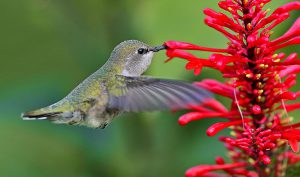
Webster’s second definition of “dog days” is a period of stagnation or inactivity. But, even when the heat forces you to slow down on the labor-intensive work, there is plenty of gardening “activity” to do. Stay in the air conditioning and plan that spectacular fall and winter yard.
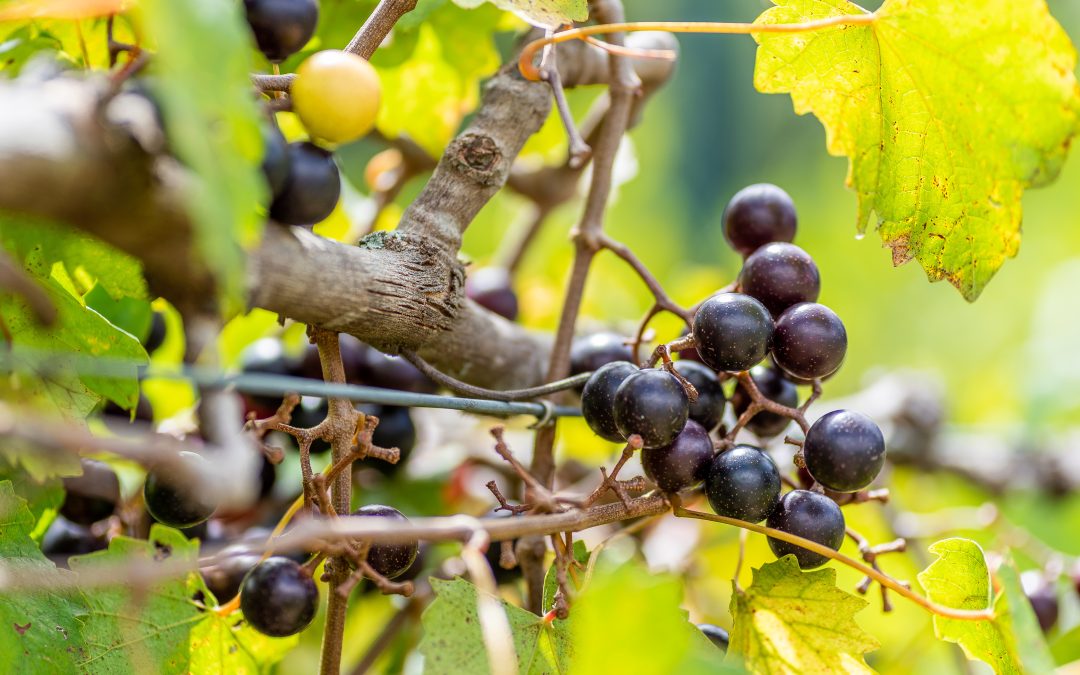
by Molly Jameson | Aug 7, 2024
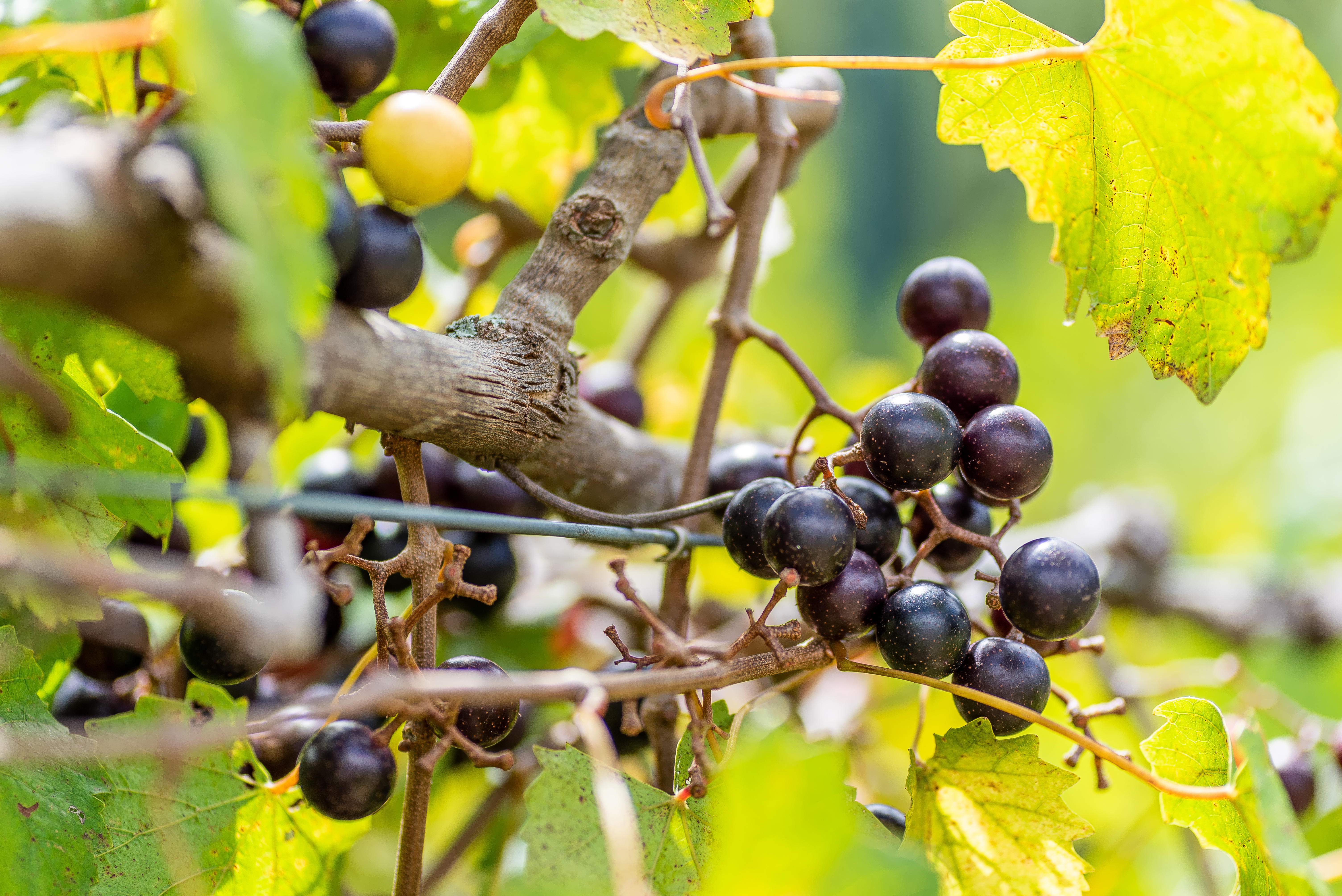
If you are planting a purple muscadine cultivar, ‘Noble’ is an ideal choice due to its productivity, disease resistance, and high-quality juice. Photo by Leonard, Adobe Stock.
Discover the Charm of Muscadines
Imagine walking through endless rows of lush grapevines, each brimming with clusters of plump, juicy muscadines. Scientifically known as Vitis rotundifolia, muscadine grapes are a species native to the southeastern US, with a range extending northward from Florida to Delaware and westward to east Texas and Oklahoma.
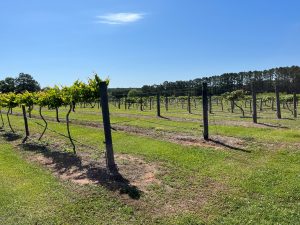
The FAMU Center for Viticulture and Small Fruit Research serves as a hub for studying and developing new cultivation techniques, aiming to enhance muscadine grape quality and resilience to various pests and diseases. Photo by Molly Jameson.
Unlike their traditional grape cousins, muscadines have a unique, robust flavor profile that is often described as rich, sweet, and pleasantly tart. For those who grew up enjoying muscadines, their taste often brings back fond memories of languid, late summer days. Here in the Panhandle, muscadines thrive in our long, hot summers and flourish in our sandy, well-drained soils.
Muscadine grapes are not only a delight for our taste buds, but they are also packed with antioxidants, vitamins, and minerals, making them a powerhouse of nutrition. The high levels of the polyphenol resveratrol, a potent antioxidant, have been linked to numerous health benefits.
In the culinary world, muscadine grapes, with their thick skins and rich colors, spark creativity and exploration. Their unique flavor makes them perfect for everything from fresh fruit to preserves, pies, tarts, and juice. And naturally, muscadine grapes are ideal for winemaking, bringing a distinct twist to the wine market.
While muscadine grapes may not possess the storied history of their European counterparts, they have a rich history of their own in the southeastern US, where they are native and have been a significant part of the region’s agricultural and cultural landscape for centuries. Native American tribes in the southeast, including the Cherokee and Seminole, were the first humans to utilize muscadine grapes. They used the grapes for food and medicinal purposes, appreciating their nutritional value and distinct flavor. In the 1500s, early European settlers, including the English explorer Sir Walter Raleigh, documented the abundance of muscadines growing wild. Seeing their potential, settlers began cultivating muscadine grapes for winemaking and other purposes.
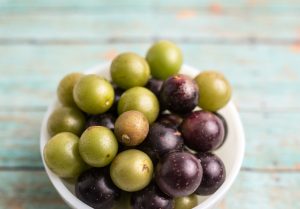
Muscadine grapes come in a variety of colors, including deep purple, black, bronze, and green, each offering its unique flavor profile and appeal. Photo by Tanya, Adobe Stock.
Unlike European grapes, muscadines are naturally more resistant to many common grape diseases, such as anthracnose and Pierce’s disease, and are less susceptible to pests due to their thick skins and natural antifungal compounds. However, they can still be affected by diseases such as angular leaf spot and other fungal rots, and pests such as grape vine borer, birds, raccoons, and deer. In contrast, European grapes are highly susceptible to a range of fungal and bacterial diseases, including powdery mildew and botrytis bunch rot, and are more vulnerable to pests, such as grape berry moths. European grapes also require specific chilling hours which cannot be achieved in the southeast US, and they are more sensitive to both drought and excessive moisture, requiring careful irrigation management and more intensive fertilization.
Today, muscadine grapes are cultivated extensively in the southeast, catering to niche markets. In Florida, there are many muscadine cultivars that thrive, each known for its unique characteristics and adaptability. Cultivars such as the purple ‘Alachua’ and ‘Noble’ and the bronze ‘Carlos’ are popular choices among growers for their high yields and suitability for winemaking, producing wines noted for their fruity flavors and distinct aroma. Muscadines like the purple ‘Supreme’ and the bronze ‘Fry’ and ‘Summit’ are renowned for their sweet taste and are often enjoyed fresh or used in jams and desserts. The muscadine harvest season typically starts in early August and goes through early October, depending on the cultivar, so it pays to grow a variety to extend the season. For more information about muscadine grape cultivars, check out the UF/IFAS Extension EDIS publication The Muscadine Grape.
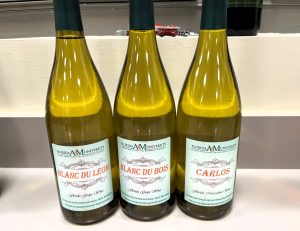
The wine produced at the FAMU Center for Viticulture and Small Fruit Research in Tallahassee showcases the region’s rich muscadine flavors with a focus on innovation and quality. Photo by Molly Jameson.
With ongoing research and cultivation efforts, Florida is broadening its range of muscadine cultivars, ensuring a diverse and thriving grape industry. This research is actively enhancing muscadine varieties, including at the Florida A&M University (FAMU) Center for Viticulture and Small Fruit Research located in Tallahassee.
Efforts at the Center focus on improving grape and small fruit cultivars, particularly those adapted to Florida’s unique climate. Their research includes enhancing disease resistance, boosting fruit quality, increasing yields, releasing new cultivars, and emphasizing sustainable agricultural practices.
Be sure to visit the FAMU Center for Viticulture and Small Fruit Research during the annual Grape Harvest Festival. This year, the festival will be held Saturday, September 14, 2024, from 8 a.m. to 3 p.m., featuring activities such as a vineyard run and walk-a-thon, insect demonstrations and computer simulations, grape varietals tasting, guided vineyard trailer rides, grape throwing and stomping competitions, a wine making workshop, grape picking, and more. Learn more and register to attend the festival at https://my.famu.edu/event/ghf24.
















